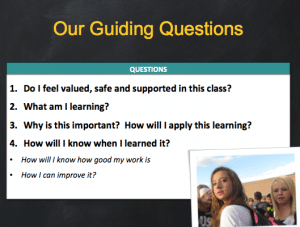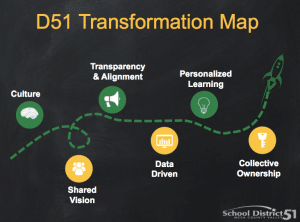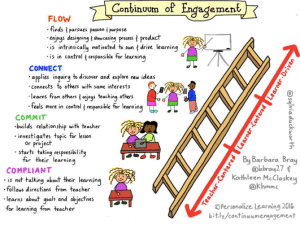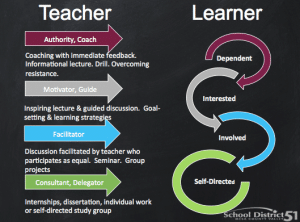The Vision of Performance-Based Education at D51
CompetencyWorks Blog
This article is the third in the Designing Performance-Based Learning at D51 series. A reminder: D51 uses the phrase performance-based learning or P-BL.
Starting with the Four Questions
 It’s feels a bit like a riddle. You see the four Guiding Questions in different places throughout Colorado’s District 51. Everyone knows the district isn’t anywhere close to being able to ensure that students can answer all four questions, but they remind you that this is what they are striving for. This technique sparks reflection and opens up minds to P-BL and the ultimate goal of personalized learning.
It’s feels a bit like a riddle. You see the four Guiding Questions in different places throughout Colorado’s District 51. Everyone knows the district isn’t anywhere close to being able to ensure that students can answer all four questions, but they remind you that this is what they are striving for. This technique sparks reflection and opens up minds to P-BL and the ultimate goal of personalized learning.
These questions go to the heart of what it means to have a transparent system that engages, motivates, and enables students to build lifelong learning skills. Yet, they start with the important question, Do our students feel valued, safe and supported? If that isn’t in place, students won’t take risks, they won’t ask for the help they need, and they won’t strive to do reach their personal best every day.
The Values Leading to the Vision
 D51 thinks about their efforts toward building a personalized, performance-based system as a transformational journey – transformational in that it is being grounded in a set of very different values, understanding of learning, and capacity than the traditional education system. (If you are new to competency education and need more information on this topic, see What is Competency Education?) Let’s call these the features of the system they are building.They are also the features of the process by which the district is going to transform their system. In other words, D51 is walking the talk.
D51 thinks about their efforts toward building a personalized, performance-based system as a transformational journey – transformational in that it is being grounded in a set of very different values, understanding of learning, and capacity than the traditional education system. (If you are new to competency education and need more information on this topic, see What is Competency Education?) Let’s call these the features of the system they are building.They are also the features of the process by which the district is going to transform their system. In other words, D51 is walking the talk.
These features of the system and the process include a culture rooted in a growth mindset; a shared vision; transparency and alignment; data driven processes; personalized learning, and collective ownership. As you read this series about D51’s journey to date, consider how each of these features may be shaping their strategies and driving their decisions.
Observation and Insight: I came to believe during my site visit that safety, trust, and respect are also a feature of D51’s work and the design of the system. It comes up in conversations along the way, but in general I think it is an operating value (although not one that is explicit as the features listed here). Given that many districts have to overcome years and years of mistrust, specifically rooted in the institutional patterns that have resulted in much lower quality of education in communities of color, I recommend that safety, trust, and respect be considered as explicit features that drive design and implementation.
What Does it Mean to Be Performance-Based?
P-BL is described in D51 as a framework that starts with transparency of expectations and is designed to create high levels of reliability in learning. Occasionally, I heard it described as a framework of effective practices, but Rebecca Midles, Executive Director of Performance-Based Systems, emphasized that it was a systemic framework.
One thing is a bit confusing to understand at D51 – personalization is rooted within the entire system design and system-building, yet they have placed personalized learning as a later phase in implementation. Their thinking is that they don’t want a watered-down version of personalized learning. In order to understand how they are designing their P-BL system, we have to start with their understanding of personalization.
Personalization
 As we all know, personalized learning can a be tricky term because it can be so closely related to terms like learner-centered, is used by some to describe online learning when they are really talking about differentiated instruction, and captures a wide, wide range of practices. Midles explained that they are very cautious about the phrase personalized learning as it can “melt down into something that coats anything and everything.” At D51, the core of personalized learning is that schools will help students to learn how to take responsibility for their learning. Thus, D51 is working to “embrace a culture where each student has ownership of his/her academic, social and emotional learning resulting in readiness for success in life.”
As we all know, personalized learning can a be tricky term because it can be so closely related to terms like learner-centered, is used by some to describe online learning when they are really talking about differentiated instruction, and captures a wide, wide range of practices. Midles explained that they are very cautious about the phrase personalized learning as it can “melt down into something that coats anything and everything.” At D51, the core of personalized learning is that schools will help students to learn how to take responsibility for their learning. Thus, D51 is working to “embrace a culture where each student has ownership of his/her academic, social and emotional learning resulting in readiness for success in life.”
Midles grounds her understanding of personalized learning in the work of Barbara Bray and Kathleen McClaskey. Their analysis is helpful in separating differentiation, individualization, and personalization. They also have a Continuum of Engagement used at D51 to help educators think more deeply about how they are organizing their classrooms and instruction to help students have more agency and connection to their learning.
As a feature of the transformational process, personalization is also about embracing the idea that in order to engage learners – including adult learners – we need to understand where they are starting from, including the social and emotional aspects of their learning. Thus, the entire implementation strategy is shaped by this feature of personalization.
The Elements of Performance-Based Structure
D51 is in the middle of designing the elements of the performance-based structure. (Future posts will delve into them more deeply.) I think of them as design “nodes” – the points of intersection and alignment that need to be managed to create a transparent, coherent system. (Remember, if it is transparent, people working in or impacted by the system, including the students, will point out any points of inconsistency!)
- Graduate profile: Used to define graduate competencies, school design, and learning experiences. Great Schools Partnership, through a partnership with Colorado Education Initiative, has been helpful in shaping the profiles.
- Shared vision, mission, and guiding principles: Used to make decisions and allocate resources from school board to classroom.
- Teaching & Learning Framework: Guides policies, professional learning, and feedback loops to teachers and new capacities and functionality in the system. Includes a set of core effective practices that enable students to take ownership and teachers to create the capacity for personalization in their classrooms.
- Competency Framework: The graduate competencies, standards, and rubrics create transparency for what students should know and be able to do at each performance level. In addition, it serves as the structure by which teachers can calibrate proficiency and ensure alignment of instruction as assessment to levels of rigor.
- Growth Mindset and Social & Emotional Learning (including Habits of Mind) standards and continuua that are used to help students build the skills of being a lifelong learner.
D51 is also exploring using a new form of decision making and communication called holacracy that is consistent with the features of the system. This may very well become part of the performance-based structure. (To be discussed in future articles.)
In the Classroom
Teachers who are learning the set of effective practices to create more learner-driven classrooms are likely to describe P-BL as a set of practices, especially given where they are in their implementation and what they have been exposed to. The goal is to create learner-centered classrooms that include:
- A growth mindset culture
- A vision that defines and stretches the learning environment
- Student-created norms
- Transparency of expectations
- Personal goal setting for behavior and academics
- Behavior expectations that are taught and growth that is celebrated
- Systems in place to support self-directed learning
- Infused choices for students within their learning
- Structures to support student voice
- Feedback loops
The current emphasis of the professional learning environment is on these effective practices: Culture (Social & Emotional Learning and Growth Mindset); Learner-Centered Environment (Backward by Design, Shared Vision & Code of Cooperation, and Workshop); and Transparency (Assessment for Learning & Rubrics). Once the P-BL structure is designed, there will be much more transparency, and demand for high reliability will increase and require additional Design Labs.
Observation and Insight: Because everything is so new for the educators at D51, these concepts felt totally alive. Classroom after classroom, teachers were trying out different ways of using the effective practices. I’ve noticed that in districts that have been doing competency education for several years, it is easy for the shared vision, code of cooperation, and standard operating procedures to become a routine sequence of steps and even slip away altogether. Thanks to the teachers and principals in D51, I gained a much deeper understanding of the practices as an essential part of a personalized, performance-based classroom. These practices, when used together, enable students to take responsibility for their learning environment, gain ownership of their education, and engage in more advanced learning strategies.
As we walked through classrooms together, Principal Leia Kraeuter of Lincoln Mesa Orchard Elementary described what she looks for in the classrooms given their stage of development (remember – they haven’t finished designing or rolling out the transparent structure of P-BL). “In addition to evidence of teachers and students using a growth mindset, I am looking for engagement of students in the classroom. I want to see students talking more and teachers talking less, a gradual release of responsibility, and teachers leveraging the time and learning experiences in the classroom.”
 During another school visit, a teacher at New Emerson Elementary explained that she is seeing immediate value in some of the effective practices. “Unpacking the standards helps students see the end point,” she said. “By increasing transparency, it increases drive.”
During another school visit, a teacher at New Emerson Elementary explained that she is seeing immediate value in some of the effective practices. “Unpacking the standards helps students see the end point,” she said. “By increasing transparency, it increases drive.”
Midles explained that just as we all shift between a fixed mindset and a growth mindset, students will also flow through different levels of dependence and self-directedness. She explained that what she hopes for is that teachers will be skilled in four of the instructional techniques based on where students are in the continuum of engagement so that students are building the skills they need for self-directed learning after high school.
Again, I just want to remind readers that D51 is in the midst of an enormous process of designing while also providing support to teachers and principals in the demonstration schools. The actual model D51 will use will become much clearer after the Teaching and Learning Framework is complete.
Read the Entire Series:
Post #1 – Designing Performance-Based Learning at D51
Post #2 – Building Consensus for Change at D51